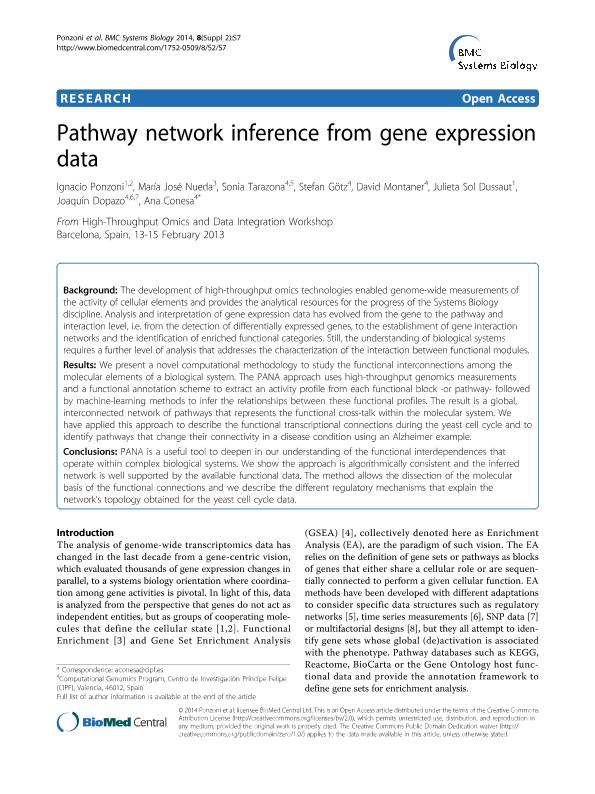Mostrar el registro sencillo del ítem
dc.contributor.author
Ponzoni, Ignacio

dc.contributor.author
Nueda, María José
dc.contributor.author
Tarazona, Sonia
dc.contributor.author
Götz, Stefan
dc.contributor.author
Montaner, David
dc.contributor.author
Dussaut, Julieta Sol

dc.contributor.author
Dopazo, Joaquín
dc.contributor.author
Conesa, Ana
dc.date.available
2017-02-03T18:59:16Z
dc.date.issued
2014-03
dc.identifier.citation
Ponzoni, Ignacio; Nueda, María José; Tarazona, Sonia; Götz, Stefan; Montaner, David; et al.; Pathway network inference from gene expression data; BioMed Central; Bmc Systems Biology; 8; supl. 2; 3-2014; 1-17
dc.identifier.issn
1752-0509
dc.identifier.uri
http://hdl.handle.net/11336/12460
dc.description.abstract
Background: The development of high-throughput omics technologies enabled genome-wide measurements of the activity of cellular elements and provides the analytical resources for the progress of the Systems Biology discipline. Analysis and interpretation of gene expression data has evolved from the gene to the pathway and interaction level, i.e. from the detection of differentially expressed genes, to the establishment of gene interaction networks and the identification of enriched functional categories. Still, the understanding of biological systems requires a further level of analysis that addresses the characterization of the interaction between functional modules. Results: We present a novel computational methodology to study the functional interconnections among the molecular elements of a biological system. The PANA approach uses high-throughput genomics measurements and a functional annotation scheme to extract an activity profile from each functional block -or pathway- followed by machine-learning methods to infer the relationships between these functional profiles. The result is a global, interconnected network of pathways that represents the functional cross-talk within the molecular system. We have applied this approach to describe the functional transcriptional connections during the yeast cell cycle and to identify pathways that change their connectivity in a disease condition using an Alzheimer example. Conclusions: PANA is a useful tool to deepen in our understanding of the functional interdependences that operate within complex biological systems. We show the approach is algorithmically consistent and the inferred network is well supported by the available functional data. The method allows the dissection of the molecular basis of the functional connections and we describe the different regulatory mechanisms that explain the network's topology obtained for the yeast cell cycle data.
dc.format
application/pdf
dc.language.iso
eng
dc.publisher
BioMed Central

dc.rights
info:eu-repo/semantics/openAccess
dc.rights.uri
https://creativecommons.org/licenses/by/2.5/ar/
dc.subject
Pathways
dc.subject
Pathway Network
dc.subject
Gene Expression
dc.subject
Bioinformatics
dc.subject.classification
Ciencias de la Información y Bioinformática

dc.subject.classification
Ciencias de la Computación e Información

dc.subject.classification
CIENCIAS NATURALES Y EXACTAS

dc.title
Pathway network inference from gene expression data
dc.type
info:eu-repo/semantics/article
dc.type
info:ar-repo/semantics/artículo
dc.type
info:eu-repo/semantics/publishedVersion
dc.date.updated
2017-02-02T14:07:25Z
dc.journal.volume
8
dc.journal.number
supl. 2
dc.journal.pagination
1-17
dc.journal.pais
Reino Unido

dc.journal.ciudad
Londres
dc.description.fil
Fil: Ponzoni, Ignacio. Universidad Nacional del Sur. Departamento de Ciencias e Ingenieria de la Computacion. Laboratorio de Investigación y Desarrollo en Computacion Cientifica; Argentina. Consejo Nacional de Investigaciones Científicas y Técnicas. Centro Científico Tecnológico Bahía Blanca. Planta Piloto de Ingeniería Química (i); Argentina
dc.description.fil
Fil: Nueda, María José. Universidad de Alicante; España
dc.description.fil
Fil: Tarazona, Sonia. Centro de Investigaciones Principe Felipe; España. Universidad de Valencia; España
dc.description.fil
Fil: Götz, Stefan. Centro de Investigaciones Principe Felipe; España
dc.description.fil
Fil: Montaner, David. Centro de Investigaciones Principe Felipe; España
dc.description.fil
Fil: Dussaut, Julieta Sol. Universidad Nacional del Sur. Departamento de Ciencias e Ingenieria de la Computacion. Laboratorio de Investigación y Desarrollo en Computacion Cientifica; Argentina. Consejo Nacional de Investigaciones Científicas y Técnicas; Argentina
dc.description.fil
Fil: Dopazo, Joaquín. Centro de Investigaciones Principe Felipe; España
dc.description.fil
Fil: Conesa, Ana. Centro de Investigaciones Principe Felipe; España
dc.journal.title
Bmc Systems Biology

dc.relation.alternativeid
info:eu-repo/semantics/altIdentifier/url/http://bmcsystbiol.biomedcentral.com/articles/10.1186/1752-0509-8-S2-S7
dc.relation.alternativeid
info:eu-repo/semantics/altIdentifier/doi/http://dx.doi.org/10.1186/1752-0509-8-S2-S7
Archivos asociados
